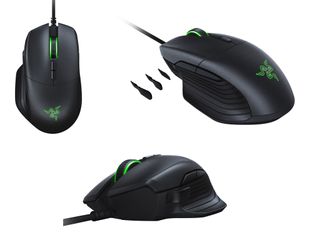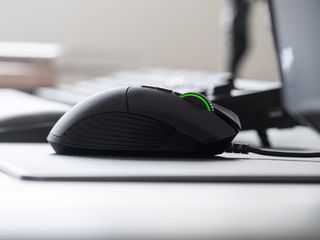New Razer Basilisk optical gaming mouse targets first-person shooter (FPS) games
The new Basilisk mouse from Razer lets players of first-person shooter (FPS) games hone their hardware for total precision.

Razer is on a streak lately, with three new mouse releases including today's announcement of the new customizable Basilisk gaming mouse. The difference with this mouse is its audience, as it is aimed squarely at people who play FPS games.
Razer Basilisk is all about the FPS

Featuring a 5G optical sensor for those who disfavor laser ones, the Basilisk (named after the legendary reptile reputed to be king of serpents) also adds a customizable scroll wheel and clutch (trigger) for gamers who want precision and comfort. That optical sensor is the same as the one found in the Razer DeathAdder Elite and Razer Lancehead Tournament Edition.
Razer describes the scroll wheel customizability as such:
The mouse offers a continuum of scroll wheel resistances to choose from. The scroll wheel can be adjusted via a dial on its underside for increased or decreased resistance to fit the preferences of each gamer. This can be especially useful for gamers who bind jump to their scroll wheel and are looking to adjust the jump activation to a preferred level of resistance.
The removable clutch is a configurable side trigger that when held down activates a temporary feature. There are two clutches included in the box – one short, one long – and an end cap if users do not want to use it at all.
Razer Basilisk tech specs
| Category | Specification |
|---|---|
| Sensor | Razer 5G optical sensor with true 16,000 DPI |
| Sampling | Up to 450 inches per second50G acceleration1,000 Hz polling |
| Connection | Wired |
| Buttons | Razer Mechanical Mouse SwitchesEight independently programmable buttons50 million clicks lifespan |
| Clutch | Two removable clutch (short/long) buttons and a rubber thumb cap |
| Wheel | Gaming-grade tactile with customizable resistance |
| Material and design | Ergonomic right-handed design with enhanced rubber side gripsRazer Chroma lighting with true 16.8 million customizable colorsInter-device color synchronization |
| Software | Razer Synapse 3 (Beta) enabled (Coming soon) |
| Dimensions (L x W x H) | 124 mm x 75 mm x 43 mm (4.88 in x 2.94 in x 1.69 in) |
| Weight | 107 g / 0.24 lbs |
By default, the Basilisk clutch will reduce dots per inch (DPI) from high to low for more precise shooting. You'll need it, too, as the Basilisk supports a massive 16,000 DPI, and like all of Razer's mice, it can be configured between 200 and 16,000 with exact precision through five presets. Other options for the Basilisk clutch include "push-to-talk, item pickup, or any other actions," all done through the Razer Synapse 3 software.


Razer Cofounder and CEO Min-Liang Tan commented about the motivation behind Basilisk:
The customizability of the Razer Basilisk sets it apart from other FPS mice and is something that we're incredibly proud of. This is a mouse designed for tweaking that last ounce of performance out of each gamer's specific FPS playstyle. For games like CS:GO, PUBG, Quake, and the likes, there's nothing better.
Different than the wireless Lancehead the Basilisk is a bit longer and lacks the ambidextrous design, but it gains some cool features like the configurable scroll wheel and that optional clutch trigger for added functionality. Being wired-only, the Basilisk can also come in at a lower price point compared to wireless gaming mice, while also not having to worry about signal interference.
Get the Windows Central Newsletter
All the latest news, reviews, and guides for Windows and Xbox diehards.

Razer Basilisk pricing and availability
Look for the Razer Basilisk to land on Razerzone.com sometime in September and worldwide in the fourth quarter of 2017.
Pricing is set at as reasonable U.S. $69.99 / EU € 69.99.
You can learn more about the Basilisk by visiting Razer's product page.

Daniel Rubino is the Editor-in-chief of Windows Central. He is also the head reviewer, podcast co-host, and analyst. He has been covering Microsoft since 2007 when this site was called WMExperts (and later Windows Phone Central). His interests include Windows, laptops, next-gen computing, and wearable tech. He has reviewed laptops for over 10 years and is particularly fond of 2-in-1 convertibles, Arm64 processors, new form factors, and thin-and-light PCs. Before all this tech stuff, he worked on a Ph.D. in linguistics, performed polysomnographs in NYC, and was a motion-picture operator for 17 years.